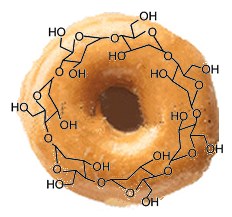Doughnut-shaped molecules could provide a sweet solution for extracting toxic and environmentally harmful compounds from industrial waste water.
According to Ashley Bibby and Louis Mercier of Laurentian University, in Sudbury, Ontario, Canada, the industrial remediation process can be improved by using a property of molecules with a central hole to act as hosts for smaller, poisonous guests. Cyclodextrins are made by certain bacteria but have found a range of uses in the chemical laboratory. These cyclic molecules are shaped rather like a doughnut with a central hole into which smaller molecules can sit.

Cyclodextrin – the molecule with a hole (illustration by David Bradley)
The researchers have trapped the water-soluble cyclodextrin molecules inside a porous silica framework to provide a robust new material (CD-HMS) that can absorb a range of water-soluble materials, including nitrophenol, nitroaniline, chlorophenol and phenol itself. Phenols are common ingredients and by-products of industries as diverse as chemical manufacture, pharmaceutical and agrochemical production, textiles and electronics industries. The CD-HMS can selectively extract these phenolic molecules from water.
Bibby and Mercier have found that the preference of certain toxic waste molecules, such as aromatic hydrocarbons, for the interior of the cyclodextrin doughnut lends itself well to extracting such molecules from water. We can achieve efficient adsorption of organic molecules from water, explains Mercier, The supported reagents we use can be prepared in a quite environmentally friendly way and should be effective under the typically harsh conditions (above ambient temperature, low pH, presence of bacteria, etc) found in industrial and waste water treatment plants.
The researchers explain that the open-framework structure of the porous silica in which there are large numbers of cyclodextrins in each pore allows a large number of phenol and other molecules to quickly enter and be trapped in the central cavity of the cyclodextrins simply by mixing the CD-HMS with the contaminated water.
In practice, the CD-HMS would be incorporated into a filter device. The adsorbed contaminants could then be released from the cyclodextrin groups by exposing the loaded CD-HMS to ethanol (in which organic molecules are highly soluble), thereby regenerating the materials, explains Mercier, The phenols could then be safely disposed of (stored in containers, incinerated, chemically or biologically degraded, recycled for chemical syntheses).
The material might also be adapted for other molecules including pesticides, volatile organic compounds, such as toluene and benzene and even drug separations. CDs will bind with many organic compounds in water simply because of the hydrophobic cavity of the molecule, adds Mercier, Molecules that have a good fit inside the cavity, however, will bind more effectively in the cavity than other molecules. Small aromatic molecules like phenols have a good fit and therefore bind effectively with the materials.
A good example of this is the team’s recent results on pesticide removal using CD-HMS. They found that when treating solutions containing a mixture of various pesticides those with aromatic functionalities (DDT for example) can be completely removed, whereas other pesticides are not adsorbed as effectively. The material is therefore selective to certain groups of molecules, but not to specific individual molecules. These more recent results will be published later in the year.
Further reading
Green Chem., 2003, 5
DOI: 10.1039/b209251b
Suggested searches
Cyclodextrins
Phenols